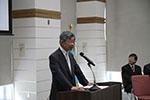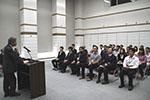2013/10/03
On Wednesday, October 2, 2013, an entrance ceremony was held in the Kenshu Hall in the Center for Frontier Science and Technology.
NAIST eagerly promotes admission of students whether from Japan or overseas with strong basic academic capabilities without being bound to a major field in university as well as researchers, engineers and others currently working actively in society who have clearly defined goals and aspirations for the future as well as strong interest and enthusiasm for research fields. This autumn 32 graduate students were granted admission to NAIST.
President Ogasawara delivered a welcome speech to the students in English for the first time, since almost all of the enrollees were international students.
*Number of Enrollees in October
【Master's Course】
Information Science 13 (12 international students)
【Doctoral Course】
Information Science 9 (8 international students)
Biological Sciences 5 (4 international students)
Materials Science 5 (3 international students)
Total 32 (27 international students)
【Congratulatory Remarks to Entering Students】
I would like to express my heartfelt congratulations to the 13 master's course students and 19 doctoral course students that entered NAIST today. On behalf of the 200 faculty and 150 staff members, I welcome you.
With 27 students from 10 countries around the world entering the university today, I have decided to give my remarks in English.
First, I would like to express my respect for those of you who have chosen to leave your home and study in Japan. Just one week ago, I awarded graduate degrees to 15 international students.
With the addition of the 27 students entering our university today, including our first student from Switzerland, there are now 144 international students from 39 different countries here at NAIST; they comprise 14% of the 1030 NAIST students. In addition, there are also 16 international research students.
Now, with the world being connected in real time via the Internet, and with the profound economic growth in Asia and Africa, globally-focused activities are demanded of those currently pursuing science and technology.
Until recently, Japanese universities tended to focus their efforts domestically, but now students and researchers are accepted from around the world, thus spreading Japanese science and technology research, and introducing Japanese society and culture far and wide.
Through university globalization efforts, it is also important that Japanese students learn about other cultures around the world as well as the current global demands on science and technology.
For the international students entering NAIST today, I hope you interact with not only Japanese students, but also with students from all over the world in both your studies and in your everyday lives. We at NAIST will actively prepare opportunities for this cultural exchange.
NAIST was established in October 1991, as a newly-conceived, independent, graduate-school-only university. At the time of its establishment, the following ideas were put forth as the mission of our institute's approach to education and research:
The fields of frontier science and technology have the following characteristics:
• wide-ranging and interdisciplinary
• include novel developments occurring from fundamental research
• produce new knowledge based on fundamental research which is then the base of technology developed in extremely short periods
• technological developments become the base of fundamental research and make further progress possible
• thus, the integration of science and technology is clearly evident
With this in mind, for the fields of frontier science and technology, the promotion of interdisciplinary fundamental researches, reaching beyond traditional, narrowly-focused academic divisions, is of extreme importance.
The following is also stated regarding education:
With the rapid developments in the areas of frontier science and technology, an important issue for both academic research and industry is the organized fostering of researchers and engineers to undertake the research and development.
Especially in these fields, it is necessary to train human resources that can respond flexibly to developments in science and technology and are capable of continuously pursuing new research fields.
In other words, NAIST was founded in order to conduct interdisciplinary research and integrate science and technology, thus extending past established areas of study, such as engineering, physical science, agriculture and medical science, in the rapidly developing frontier fields of information, biological and materials sciences.
With this as our foundation, NAIST develops human resources that actively adjust to developments in science and technology, and are competent to continually cultivate new areas of research.
In relation to NAIST's education and research mission, this is a very exciting period for science and technology development.
In information science, 20 years ago, the Internet had just begun to spread into society, but now, with the world being connected in real time through the Internet, and through the incredible advances in computer capabilities, we have entered an era of 'big data', which includes scientific and technological data.
In biological sciences, the era of studying individual gene structures and functions has given way to the current stage in which we can easily determine plant, animal, and human genomes through revolution of DNA sequencing technology, allowing us to research the origin of the diversity of living things.
Furthermore, in materials science, advancements in analysis and measurement technology have uncovered an advanced world of materials, allowing for the creation of new materials that were unimaginable twenty years ago.
With these science and technological advances, new interdisciplinary fields of research are being created, covering information, biological and materials sciences, such as the integrated field of computational biology from information and biological sciences.
The distance between fundamental science and technology research and their developments in society is much shorter than 20 years ago.
I believe that when you graduate from NAIST and take positions as researchers in society, the impact of the developments in science and technology will be farther reaching than we can imagine now.
I hope that you broaden your vision and expand your knowledge at NAIST so you may respond flexibly to developments in science and technology, and are capable of opening doors to new fields of research.
Professor Shinya Yamanaka, who received the Nobel Prize for Physiology or Medicine last year, started his Nobel Prize research here at NAIST. A monument commemorating this achievement will be opened tomorrow in the building of Biological Sciences. Please visit it.
His research pertains to the adding of genes to a somatic cell and creating a pluripotent stem cell that may be used as an omnipotent cell in tissue engineering.
Do you know the background behind how he developed this idea?
The accumulation of various researches is pointed out as the background of his successful idea.
This background includes work such as a database project collecting expressing genes in various human organ tissues, bio-informatics extracting biological information from this database and the development of technology to efficiently introduce genes into a cell.
At that time Professor Yamanaka saw the trends in frontier research and brought them together in his head to conceive an original plan for his research.
In starting this research he asked for the cooperation of top researchers in various fields.
I want to impart to you the importance of developing the ability to view and use the trends of various fields creatively, not being locked in your own area of expertise.
From now you will all enter different laboratories and continue your studies and research, but you may be able to achieve interesting results through the adoption of methods and ideas from other laboratories.
At NAIST the walls between each laboratory and graduate school are not high, so I hope you interact with a wide variety of people.
In a report last week from the IPCC, a government panel concerned with weather changes, there are grave predictions that within the next 20 years the average world temperature will rise a possible 4.8 degrees and the sea level will rise as much as 81 cm.
Furthermore, it is highly possible that human activities are responsible for these changes in the weather and environment, the report states.
While dealing with the problems of natural resources, energy restrictions and global warming in relation to human activities, the importance of science and technology to create a sustainable society has become even clearer.
In order to solve the future problems facing our world, new advances in science and technology must be developed.
It is said that there must now be a shift from a society that pursues uniform affluence and convenience to a sustainable society where varied affluence is pursued, but the creation and utilization of such an unprecedented new world requires human resources that are ready to meet this challenge.
As I mentioned earlier, it is my sincere hope that Japanese students and international students alike will share with and understanding each other deeply.
And through your experiences together, I'd like each of you to contribute as scientists to the future of Japan, Asia, and the world.
I address you today with great expectations that your student lives, and indeed your futures, will be purposeful and significant.
Congratulations once again on entering NAIST. All members of the faculty and staff welcome you wholeheartedly.
Nara Institute of Science and Technology
President Naotake Ogasawara






